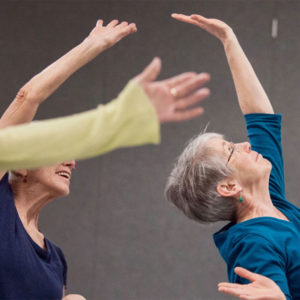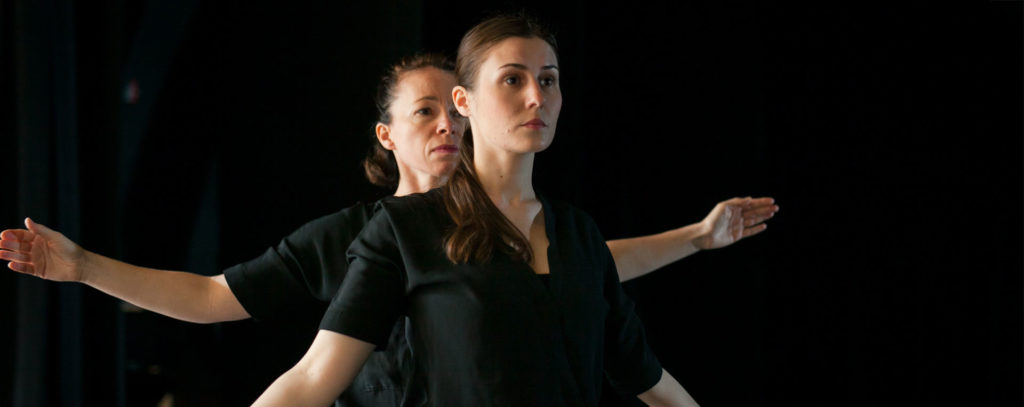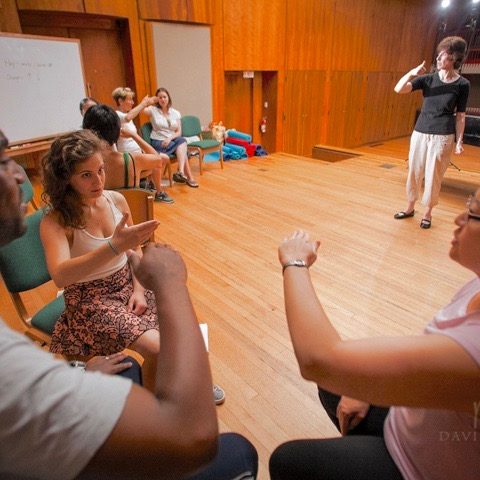Branches of Dalcroze Education
Dalcroze Education is divided into three core branches: eurhythmics, solfège, and improvisation; plus two applied branches: Plastique Animée and pedagogy. Discover what these branches mean and how they interact.
Core Branches
- Eurhythmics
- Solfège
- Improvisation
Applied Branches
- Plastique Animée
- Pedagogy
Eurhythmics
Eurhythmics is the use of movement to embody musical concepts, and rhythm is central to every lesson. Rhythm is not simply timing. Instead, it is a flow of motion that gives shape and life to music.
Émile Jaques-Dalcroze developed a movement vocabulary that categorized movements into two types:
Movements in Place
- Clapping
- Swinging Turning
- Conducting
- Bending
- Swaying
- Speaking
- Singing
Movements in Space
- Walking
- Running
- Crawling
- Leaping
- Sliding
- Galloping
- Skipping
Solfège

Solfège trains the ear, eye, and voice in pitch, melody, and harmony. It enables the student to listen to music and transcribe it onto paper or to look at sheet music and hear it internally without the use of an instrument.
Émile Jaques-Dalcroze crafted the “Rules of Nuance and Phrasing,” which provide a set of instructions that guide performers in the expression of melody. For example, how should repeated notes be performed? How should an ascending (or descending) melody be shaped?
Find a deeper exploration of solfège in An Introduction to Dalcroze’s Solfège Pedagogy by Greg Ristow.
Improvisation
Improvisation is spontaneous musical creation using the body, voice, or instrument.
Students are called upon to try things out, take risks, and discover new solutions. Improvisation empowers participants to personalize their education and make the music their own.
Improvisation figures in many ways, from the physical actions students improvise, to the music the teacher invents that shapes students’ experience. Improvisation calls upon students to engage with raw materials—rhythmic, melodic, harmonic, kinesthetic, or otherwise—and with each other.
Improvisation can be playful and purposeful, disciplined and free, intuitive and aware. It is an infinitely adaptable creative expression.
- Spontaneous synthesis and exploration of learned materials: music theory in action
- Multiple contexts that espouse joy and the spirit of play through social interaction
- Musical (piano, voice, or other instrument)
- Solo, ensemble
- Movement

Plastique Animée
Plastique Animée is an artistic exercise in moving to music where participants embody or “become” a piece of music, using gesture and movement to reflect specific musical elements.
Students draw purposeful connections between music and movement in order to deepen their understanding of a piece. A Plastique Animée can take on many forms, from informal classroom experiences to formal staged presentations.
Generally, Plastique Animée requires the movers to:
- Analyze a musical score and improvise movements
- Refine movements that authentically represent key musical elements
- Rehearse and solidify (and potentially present)
A Plastique Animée may be presented or directed by solos, duos, or groups.
Pedagogy
Pedagogy: teachers improvise on their lesson plans based on the students’ responses.

Further Reading
• Video: Organic Rhythm with Dawn Pratson (Alex Marthaler)
• Video: Introduction to Eurhythmics with Dr. Annabelle Joseph (Alex Marthaler)
• Video: Children’s Dalcroze Eurhythmics with Dr. Jeremy Dittus (Alex Marthaler)
• Dalcroze Eurhythmics with Lisa Parker (Alex Marthaler)
